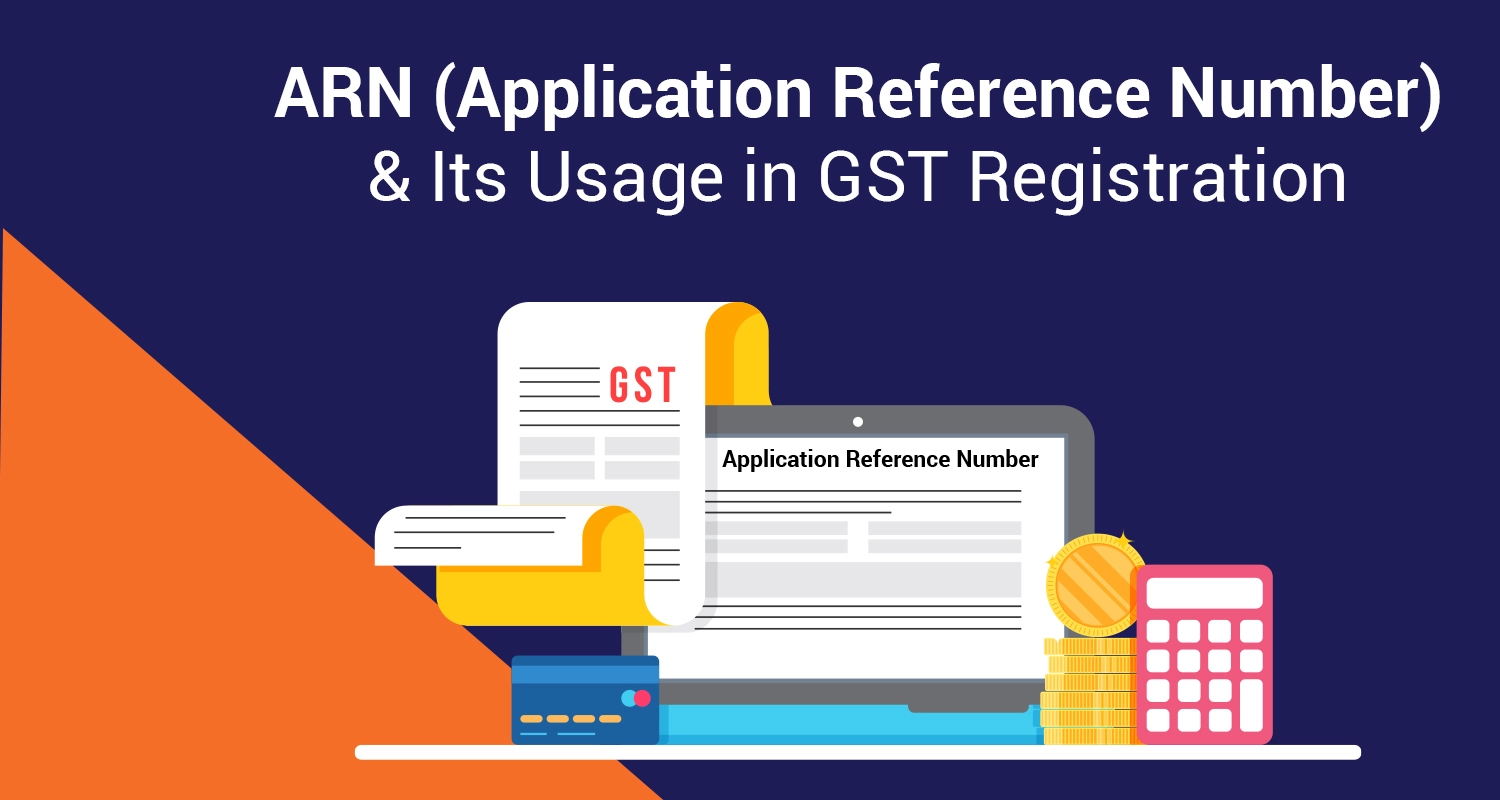Steps to Generate ARN, its Usage, importance & Benefits

With the growing complexity of the Indian economy, the government has introduced a very efficient and comprehensive taxation system for goods and services in the country called GST, or Goods and Services Tax. This revolutionary system has replaced many previous indirect taxes, and today, everything from registration to return filing to refunds or tax payments is made online on the GST Portal. As a result, the ARN or Application Reference Number (ARN) plays a critical role in GST's online functionalities.
When you successfully apply for GST Registration, an Application Reference Number (ARN) is automatically generated. This unique number is a crucial part of the GST system, serving as valid proof of your registration application until the Goods and Services Tax Identification Number (GSTIN) is issued.
This article will give more detailed information like the ARN full form in GST, what ARN leverages in the GST system, its importance, and how you can understand the GST ARN status. Read on to learn more on ARN:
What is Application Reference Number in simplest terms?
The Application Reference Number (ARN) is a unique 15-digit alphanumeric code allotted to each GST registration application. It serves as a reference and identification number throughout the application process until the issuance of the GSTIN. It is also a temporary ID that helps you track the progress of your registration application on the GST Portal.
How is ARN generated, and how long does it take?
The GST Portal automatically creates an ARN with the submission of a GST registration application. When the application is effectively filed, the system allots a unique ARN to it. This number acts as a reference for any subsequent inquiries or clarifications associated with the application. The ARN is usually available instantly or within a short span of time after submitting the GST registration application.
What are the features of ARN?
- Input Tax Credit (ITC): The Application Reference Number (ARN) is essential for claiming ITC in the GST system.
- Cascading Tax Prevention: ITC prevents double taxation by allowing businesses to claim credit for taxes paid on purchases.
- Reduced Tax Liability: ITC helps businesses reduce their overall tax liability.
- Benefit to End Consumers: Ultimately, reduced tax liability can lead to lower prices for consumers.
- Timely Claims: Businesses must claim ITC within the specified time limits to comply with GST regulations.
Sapna aapka. Business Loan Humara.
Apply NowWhat are the benefits of ARN?
- Transparency: ARN provides visibility into the status of your GST application.
- Efficiency: A verified ARN streamlines the registration process.
- Confidence: Tracking progress reduces doubts and boosts confidence in business growth.
- Compliance: Validating the ARN ensures compliance with GST regulations.
- Communication Tool: ARN is useful for communication and resolving issues.
- Vendor Verification: ARN helps verify the authenticity of vendors.
Are there any different types of ARN?
- Sole Proprietorship: For businesses owned by a single individual.
- One-Person Company: For a company with a single member.
- Partnership Firm: For businesses owned by multiple individuals.
- Limited Liability Partnership (LLP): For partnerships where partners have limited liability.
- Private Limited Company: For privately-held companies with limited liability.
- Public Limited Company: For publicly-traded companies with limited liability.
What are the steps involved in generating ARN?
The ARN Number generation process has a few steps as follows:
- Step 1: Submitting GST Registration Application: Initially, an applicant submits his GST registration through the GST portal. The necessary details and the documents need to be uploaded.
- Step 2: Application completion: With the complete application and all mandatory details filled, the applicant submits the form online.
- Step 3: Automatic Generation of ARN: With the completion of submission of the GST registration application, the GST portal automatically generates an Application Reference Number (ARN)
- Step 4: Receipt of ARN: The ARN is sent to the applicant via email, or you can also note it down directly from the GST portal immediately after submitting your GST application.
- Step 5: Tracking with ARN: The ARN number is very important as it allows the GST certificate applicant to track the status of the GST registration application on the GST Portal till the final GSTIN (Goods and Services Tax Identification Number) is issued by the government.
How to check GST registration status online
Here are the steps that you should follow to check the registration status
Step 1: Visit the GST official portal.
Step 2: Go to the 'services' tab and look for a header named 'registration.'
Step 3: Once you click on the 'registration' header, you’ll get three options: 'New Registration', 'track application status', and 'application for filing clarifications'
Step 4: Now, click 'track application status' and enter your ARN in the given space. Enter the captcha code in the next step and click on 'search'. Soon, you will receive your GST registration status on your screen within seconds. Remember to read the terminology carefully as each represents a different information set.
Importance of Knowing ARN Types
Understanding the different types of GST ARN application statuses is crucial for businesses in India. It helps you:
- Choose the Right Business Structure: Select the most suitable business structure based on your specific needs and goals.
- Register Correctly: Ensure that you apply for the correct type of GST registration to avoid delays and complications.
- Comply with Regulations: Understand the specific requirements and obligations associated with your chosen business structure.
- Access Government Benefits: Some business structures may be eligible for certain government benefits or incentives.
Can you describe the Procedure for checking GST registration application status using ARN?
Once you have logged in to the GST Portal, you can track the status of various applications like new registrations, amendments, or cancellations. Here is a step by step know how to explain the procedure to check the application status using the GST portal:
- Visit to Log in to the GST portal and go to Services > Track Application Status.
- Select “Registration” from the dropdown menu under the Module category in the’ Track Application Status’ section.
- You can track the application's status using the ARN (Application Reference Number), SRN (Service Request Number), or submission date.
- To access the acknowledgment, click on the “download” hyperlink.
The above feature helps registered users easily monitor the progress of different types of GST-related applications, stay updated on their status, and oversee the overall management of GST compliance using ARN.
Conclusion
The good thing about the taxation system is that the ARN proves the developed technology to simplify intricate systems like the GST. The GST process must become simpler and less intimidating as it empowers taxpayers, maintains clarity, and fosters efficiency. ARN is a beacon pointing a way towards a more efficient and prolific system as we realise its great potential and make use of technological innovations.
GST has brought about a revolution in the taxation system by introducing a new phase of economic efficiency in procedures, thereby impacting the overall economy.
FAQs
Q1. Who needs to register for GST?Ans. Not all businesses need to register for GST. It depends on your annual turnover and the type of goods or services you provide. You can find a GST registration threshold on the GST portal or consult a tax advisor to determine if you need to register.
Q2. What documents are required for GST registration?Ans. The documents required for GST registration can vary depending on your business type. But generally, you'll need documents like PAN card, Aadhaar card, address proof, business registration documents, and bank account details.
Q3. What are the benefits of registering for GST?Ans. Registering for GST has several benefits, such as claiming input tax credit (ITC) on purchases, availing composition scheme benefits (for small businesses), and establishing credibility for your business.
Q4. What happens after I submit my GST registration application?Ans. Once you submit your application, the authorities will review it. You can track the application status using the GST portal. You'll receive a GST Identification Number (GSTIN) if your application is approved.
Q5. What are the ongoing GST filing requirements?Ans. After obtaining GSTIN, you'll need to file GST returns regularly. The frequency of filing depends on your turnover. These returns detail your sales and purchases, allowing the government to calculate your GST liability.
Sapna aapka. Business Loan Humara.
Apply NowDisclaimer: The information contained in this post is for general information purposes only. IIFL Finance Limited (including its associates and affiliates) ("the Company") assumes no liability or responsibility for any errors or omissions in the contents of this post and under no circumstances shall the Company be liable for any damage, loss, injury or disappointment etc. suffered by any reader. All information in this post is provided "as is", with no guarantee of completeness, accuracy, timeliness or of the results etc. obtained from the use of this information, and without warranty of any kind, express or implied, including, but not limited to warranties of performance, merchantability and fitness for a particular purpose. Given the changing nature of laws, rules and regulations, there may be delays, omissions or inaccuracies in the information contained in this post. The information on this post is provided with the understanding that the Company is not herein engaged in rendering legal, accounting, tax, or other professional advice and services. As such, it should not be used as a substitute for consultation with professional accounting, tax, legal or other competent advisers. This post may contain views and opinions which are those of the authors and do not necessarily reflect the official policy or position of any other agency or organization. This post may also contain links to external websites that are not provided or maintained by or in any way affiliated with the Company and the Company does not guarantee the accuracy, relevance, timeliness, or completeness of any information on these external websites. Any/ all (Gold/ Personal/ Business) loan product specifications and information that maybe stated in this post are subject to change from time to time, readers are advised to reach out to the Company for current specifications of the said (Gold/ Personal/ Business) loan.



